After 3 weeks stuck in Flagstaff, Az due to weather, I'm finally heading back out into the field. I was very fortunate that I left the desert when I did, otherwise I would have been stuck with a 5 mile hike to the nearest town (not that far unless you're hiking through snow on uneven terrain) for supplies. During the last three weeks, I've remained optomistic that the weather would change and that the snow would melt. For three weeks, it didn't. In fact, it just kept snowing. This is definately not how I pictured Arizona in March.
After being confined here as long as I have, I started to consider my options. I could go west back to California and stay at my parents' place until the snow here melted or I could continue east until I was out of the snow. The latter option would take me as far as Texas. The Texas panhandle however has been on fire. Close to one million acres have been burned by wild fires, resulting in the deaths of over 11 thousand horses and cattle, as well as two people. Given my luck, I would have gone out to a site and been just out of range of either cell phone or radio reception when wild fire would sweep through the area. Besides, ash is worse for finding fossils than snow. It drifts, but it doesn't melt. Further east then, into the main body of Texas? No. Just as I was deciding how far east to go, the weather changed dramatically and the snow melted. Three inches of snow fell on tuesday. Today it's nearly all gone. Some might see the hand of providence in all this; quietly suggesting when I should leave an area, or when I should stay. No, it's just nature tending toward maximum irony.
Thursday, March 23, 2006
Tuesday, March 21, 2006
More Book Reviews
As I said in the previous post of book reviews, the one nice thing about being stuck in Flagstaff is that I've gotten alot of reading done. And so, here are the reviews of the four books, in order, that I've just finished reading. I admit, I wish that I had read them in a different order.
Aristotle Indeed
One of my favorite authors is Will Cuppy. There's a good chance that unless you've heard me talk about him, you've never heard of him before. I don't blame you, nobody's perfect. Cuppy mostly wrote humorous but well researched articles about various extinct and extant animals. One recurring subject however was Aristotle. Cuppy loved to lambast Aristotle for his various follies in describing the natural world. For instance, Cuppy reports that aristotle believed the chambered nautilus to float at the surface of the water, using its shell like a boat and its two broadest appendages as sails.
It was with this critical frame of mind that I sat down to read Aristotle's Historia Animalia. I even had a pad of paper to write down every error as I read it, so that I could write a very long post about how silly and quaint the philosopher was. It was perhaps the only time in my life that I've been disappointed by someone being smarter and more reasonable that I thought that he or she would be.
Most of Aristotle's errors arose from a problem with homology vs. analogy. For examle, he states that the knee's of all blooded terrestrial animals that have hair or feathers (witht he exception of humans and apes) point backwards. In our modern perspective, we know that it isn't the knee that points backwards, but the ankle in all tetrapods that does so. The confusion arises from the fact that most animals adapted to a cursorial lifestyle have a short femur and a long set of foot bones that are held off the ground, giving the appearance of having a knee that points backwards. If you ask any child which way the knee of an ostrich or a horse bends, it would probably reply "backwards."
Another thing that I thought must be a gigantic error was the claim that "women produce semen." However, when you look at it from an ancient point of view, this is actually much closer to the truth than it sounds. Biblical scholars believed that a woman was essentially like the soil that a man's seed was planted in; that if you looked inside of a sperm cell, you'd see a little person and that if it was a male little person, he would also have proportionately sized sperm which contained even smaller descendants. Aristotle however believed that both a woman and a man had to contribute some form of semen from which the egg/ fetus was formed. From disections, Aristotle saw that the ovaries were connected to the uterus, and it to the other parts of the anatomy in the same way that the testes were attached to a common tube which connected to excretory organs. In animals with a cloaca, this was clearest, and there were greater degrees of seperation of the excretory and reproductive systems as animals became more advanced. All things considered, this is a very advanced way of looking at things.
Other errors that Aristotle committed arose from base assumptions on which he grounded his assumptions: that the right side of the body was interently better than the left, that the closer a bit of the anatomy was to heaven the more spiritually important it was (eg, most animals hold their heads in line with or only slightly above the horizontal line of the body but only people and birds, both of which capable of creating music, hold the head above the body. Only people have their heads directly above the body.), that you could tell a someone's personality from their facial fetures, and that information reported by his collegues was correct more often than not. This last assumption led to the belief that somewhere in africa there was a racy of tiny people who rode tiny horses and raised tiny cattle, rarher like Lilliput.
All together, I have to admit that perhaps Will Cuppy was more of an eisegete than I would normally like to admit of someone that I like.
Alice's Adventures inWonderland and Through the Looking Glass
Lewis Carroll, aka Charles Lutwidge Dodgson, was a genius. If you wonder about the alternate name, it's because the second is his given name, under which he published works on mathematics. People who have a natural flare for both mathematics and the arts (see also M.C. Escher & Bento) are no doubt all at least a little strange. Carroll certainly pushed the limits. Every chapter in his Alice books is positively abserd; filled with poetry, word games and character that take everything too literally. Unlike most victorian literature that has a young protagonist, Alice learns absolutely nothing of any practical use from her adventures and is by far the most reasonable person right from the start. After reading these two books, I'm sure that Carroll must be either the father of modern british humor, or at least the crazy uncle.
Harry Potter and the Complete Lack of Surprise
Rowling's books keep getting longer and longer, but the same amount of material seems to be covered in each. After reading Harry Potter and the Half Blood Prince, I didn't feel that much more had happened than in The Chamber of Secrets. The primary difference was amount of space devoted to character developement. Getting just about everybody in the book to fall in love with each other at some point or another takes up alot of pages. Not only that, but a tremendous amout of time was spent with Harry and his friends not really solving anything. Given that it was leaked that Dumbledore dies at the end of the book, possibly before the book was even released, it made it difficult for me to appreciate the ending when it happened. Even so, from the second chapter it was kind of obvious. Rowling's books follow a pattern: Harry and his friends enjoy a year at Hogwarts, wherein they solve a mystery, grow up a little, fight Voldemort or his forces and a good guy dies. The person that dies in each book is more important each time than the person who died at the end of the previous book. We all know that Harry can't die (at least until the very end) and it's hard to find someone more important to Harry than Syrius Black without going strait to Dumbledore.
My prediction is that book 7 will not be the ninal volume unless it is exceptionally thick (six inches wide at least). Rowling is richer than the queen of England; why kill the goose that's laying so many golden eggs? Of course, if the series doesn't end by book eight or nine, the readers might get a bit upset.
Chuck Palahniuk's Diary
High art is what an artist calls the attempt of another artist at a profound statement about art. Oscar Wilde did this with A Picture of Dorian Grey, Richard Russo tried this with Straight Man, Tim Burton's attempt was Edward Scissor Hands, and Chuck Palahniuk's claim to high (literary) art is Diary. This novel is almost exactly like every other Chuck Palahniuk novel; all the motifs are there:
1. Being abandoned
2. You always hurt the one's you love
3. The only way to acheive greatness is through suffering - "Self improvement is masterbation" (Fight Club). Another, almost identical motif is that the only way to be saved, is to be destroyed.
4. By the end of the book, the protagonist is toxified, emaciated and trying very hard to save society from themself.
5. The service industry sucks the life/soul out of you, and almost everyone these days is in the service industry.
6. All the characters are well educated and never hesitate to spout esoteric knowledge gained from what they ultimately felt was a wasted education.
7. Prominant architecture is destroyed at the end. This only happens in about half of Palahniuk's works, like the film version of Fight Club, but not the novel.
8. Once again, Palahniuk's disjointed, first person sentence structure has screwed with my internal monologue.
What differentiates Diary as Palahniuk's claim to high art is that the protagonist is a a failed art student instead of a failed something else. This gives the author the avenue to wax bitterly poetic about art history; the diseases of great painters, the pretense of visiual irony among modern artists -"Just smelling super gross doesn't make their work art." Furthermore, Palahniuk writes that "Nothing you ever create is original becuase everything you do is a self portrait. Shows some part of yourself." Given that, Chuck must be one really messed up guy, I mean seriously mentally fucked up. Every book is how he sees himself, his life, or at least that's what he's trying to say. The poor tortured artist.
What Diary lacks, that all the other books possess, is (and this really spoils it for you) a good surprise ending. Unlike all other books that I've read by this author, this book ends exactly the way you think it will. By the time that you're half way through the book, a cynical reader has figured out the conspiracy and all that remains are a few twists at the end that really don't change how you perceive the whole situation. There's no "because we're the same person," no "I shot myself," no "she's a mental patient too." No, it's just stuff like "turns out he was gay, who knew?" and "by the way, I was in on it the whole time." This isn't to say that the ending isn't twisted, it is. It's just that an intelligent reader sees the ending coming a mile away, by about the middle of the book.
Aristotle Indeed
One of my favorite authors is Will Cuppy. There's a good chance that unless you've heard me talk about him, you've never heard of him before. I don't blame you, nobody's perfect. Cuppy mostly wrote humorous but well researched articles about various extinct and extant animals. One recurring subject however was Aristotle. Cuppy loved to lambast Aristotle for his various follies in describing the natural world. For instance, Cuppy reports that aristotle believed the chambered nautilus to float at the surface of the water, using its shell like a boat and its two broadest appendages as sails.
It was with this critical frame of mind that I sat down to read Aristotle's Historia Animalia. I even had a pad of paper to write down every error as I read it, so that I could write a very long post about how silly and quaint the philosopher was. It was perhaps the only time in my life that I've been disappointed by someone being smarter and more reasonable that I thought that he or she would be.
Most of Aristotle's errors arose from a problem with homology vs. analogy. For examle, he states that the knee's of all blooded terrestrial animals that have hair or feathers (witht he exception of humans and apes) point backwards. In our modern perspective, we know that it isn't the knee that points backwards, but the ankle in all tetrapods that does so. The confusion arises from the fact that most animals adapted to a cursorial lifestyle have a short femur and a long set of foot bones that are held off the ground, giving the appearance of having a knee that points backwards. If you ask any child which way the knee of an ostrich or a horse bends, it would probably reply "backwards."
Another thing that I thought must be a gigantic error was the claim that "women produce semen." However, when you look at it from an ancient point of view, this is actually much closer to the truth than it sounds. Biblical scholars believed that a woman was essentially like the soil that a man's seed was planted in; that if you looked inside of a sperm cell, you'd see a little person and that if it was a male little person, he would also have proportionately sized sperm which contained even smaller descendants. Aristotle however believed that both a woman and a man had to contribute some form of semen from which the egg/ fetus was formed. From disections, Aristotle saw that the ovaries were connected to the uterus, and it to the other parts of the anatomy in the same way that the testes were attached to a common tube which connected to excretory organs. In animals with a cloaca, this was clearest, and there were greater degrees of seperation of the excretory and reproductive systems as animals became more advanced. All things considered, this is a very advanced way of looking at things.
Other errors that Aristotle committed arose from base assumptions on which he grounded his assumptions: that the right side of the body was interently better than the left, that the closer a bit of the anatomy was to heaven the more spiritually important it was (eg, most animals hold their heads in line with or only slightly above the horizontal line of the body but only people and birds, both of which capable of creating music, hold the head above the body. Only people have their heads directly above the body.), that you could tell a someone's personality from their facial fetures, and that information reported by his collegues was correct more often than not. This last assumption led to the belief that somewhere in africa there was a racy of tiny people who rode tiny horses and raised tiny cattle, rarher like Lilliput.
All together, I have to admit that perhaps Will Cuppy was more of an eisegete than I would normally like to admit of someone that I like.
Alice's Adventures inWonderland and Through the Looking Glass
Lewis Carroll, aka Charles Lutwidge Dodgson, was a genius. If you wonder about the alternate name, it's because the second is his given name, under which he published works on mathematics. People who have a natural flare for both mathematics and the arts (see also M.C. Escher & Bento) are no doubt all at least a little strange. Carroll certainly pushed the limits. Every chapter in his Alice books is positively abserd; filled with poetry, word games and character that take everything too literally. Unlike most victorian literature that has a young protagonist, Alice learns absolutely nothing of any practical use from her adventures and is by far the most reasonable person right from the start. After reading these two books, I'm sure that Carroll must be either the father of modern british humor, or at least the crazy uncle.
Harry Potter and the Complete Lack of Surprise
Rowling's books keep getting longer and longer, but the same amount of material seems to be covered in each. After reading Harry Potter and the Half Blood Prince, I didn't feel that much more had happened than in The Chamber of Secrets. The primary difference was amount of space devoted to character developement. Getting just about everybody in the book to fall in love with each other at some point or another takes up alot of pages. Not only that, but a tremendous amout of time was spent with Harry and his friends not really solving anything. Given that it was leaked that Dumbledore dies at the end of the book, possibly before the book was even released, it made it difficult for me to appreciate the ending when it happened. Even so, from the second chapter it was kind of obvious. Rowling's books follow a pattern: Harry and his friends enjoy a year at Hogwarts, wherein they solve a mystery, grow up a little, fight Voldemort or his forces and a good guy dies. The person that dies in each book is more important each time than the person who died at the end of the previous book. We all know that Harry can't die (at least until the very end) and it's hard to find someone more important to Harry than Syrius Black without going strait to Dumbledore.
My prediction is that book 7 will not be the ninal volume unless it is exceptionally thick (six inches wide at least). Rowling is richer than the queen of England; why kill the goose that's laying so many golden eggs? Of course, if the series doesn't end by book eight or nine, the readers might get a bit upset.
Chuck Palahniuk's Diary
High art is what an artist calls the attempt of another artist at a profound statement about art. Oscar Wilde did this with A Picture of Dorian Grey, Richard Russo tried this with Straight Man, Tim Burton's attempt was Edward Scissor Hands, and Chuck Palahniuk's claim to high (literary) art is Diary. This novel is almost exactly like every other Chuck Palahniuk novel; all the motifs are there:
1. Being abandoned
2. You always hurt the one's you love
3. The only way to acheive greatness is through suffering - "Self improvement is masterbation" (Fight Club). Another, almost identical motif is that the only way to be saved, is to be destroyed.
4. By the end of the book, the protagonist is toxified, emaciated and trying very hard to save society from themself.
5. The service industry sucks the life/soul out of you, and almost everyone these days is in the service industry.
6. All the characters are well educated and never hesitate to spout esoteric knowledge gained from what they ultimately felt was a wasted education.
7. Prominant architecture is destroyed at the end. This only happens in about half of Palahniuk's works, like the film version of Fight Club, but not the novel.
8. Once again, Palahniuk's disjointed, first person sentence structure has screwed with my internal monologue.
What differentiates Diary as Palahniuk's claim to high art is that the protagonist is a a failed art student instead of a failed something else. This gives the author the avenue to wax bitterly poetic about art history; the diseases of great painters, the pretense of visiual irony among modern artists -"Just smelling super gross doesn't make their work art." Furthermore, Palahniuk writes that "Nothing you ever create is original becuase everything you do is a self portrait. Shows some part of yourself." Given that, Chuck must be one really messed up guy, I mean seriously mentally fucked up. Every book is how he sees himself, his life, or at least that's what he's trying to say. The poor tortured artist.
What Diary lacks, that all the other books possess, is (and this really spoils it for you) a good surprise ending. Unlike all other books that I've read by this author, this book ends exactly the way you think it will. By the time that you're half way through the book, a cynical reader has figured out the conspiracy and all that remains are a few twists at the end that really don't change how you perceive the whole situation. There's no "because we're the same person," no "I shot myself," no "she's a mental patient too." No, it's just stuff like "turns out he was gay, who knew?" and "by the way, I was in on it the whole time." This isn't to say that the ending isn't twisted, it is. It's just that an intelligent reader sees the ending coming a mile away, by about the middle of the book.
Thursday, March 16, 2006
Belated Book Reviews
As a hermit, one gets to do a good deal of reading, and in the name of fairness I'll give you all my latest book reviews in one dose rather than torture you with them over a long period of time. In fact, you don't even have to scroll past them if you don't want to. However, if you care to, simply follow the link to the full post.
Good Omens = good read
If you liked the movie Dogma and you like the writing of Douglas Adams, then there's an excellent chance that you'll enjoy Good Omens. The premise is as follows: A satanic order of talkitive nuns accidentally misplaces the antichrist, who incidentally turns out to be a really nice kid. Meanwhile, the minions of heaven and hell amass for the final battle at armaggeddon, the four bikers of the apocolypse (war, famine, death and pollution; plague retired in the 30's mumbling something about mold) converge on a small idealic village in Brittain and an angel and demon who were both proven incompetant a few days after the creation bend their awesome power and subhuman free will towards preventing the end of the world. Owing the the multiple plains of existance on which the story takes place, there are alot of characters, but it all comes together like the end of a Guy Ritchie movie. And all of this, as the book explains, was fortold in "the nice an acurate prophecies of Anges Nutter: witche" which, while indeed acurate, was the most unsuccessful book of prophecy ever published.
Furthermore, I'd like to thank Mr. Tyler Shaw for recommending the book. If he doesn't read this blog, more's the pitty.
Treasure Island:
This is one of those books that is so famous that everybody knows the story; so well in fact, that not many people that i've spoken to have actually read it. R.L. Stevenson definately wrote this book for kids, there is no doubt about it. It is fast paced, the plot is simple enough and all of the characters are rather flat. Many have hailed treasure island as a 'growing up' story, wherein Jim Hawkins (who's own father dies early in the book) learns a great deal from Long John Silver and their voyages at sea. This idea has so well permiated thought about the book that adaptations are forced write that stuff in. Disney's Treasure Planet is the worst offender in that department; though given all the other liberties that they took with the story, it can certainly be understood.
Despite these seeming literary short comings, Treasure Island is is very enjoyable in much the same way as The Coral Island is more enjoyable than Robinson Crusoe and episodes 4, 5 & 6 of Star Wars are more enjoyable than episodes 1, 2 & 3.
Robinson Crusoe:
This was the origin of the ship-wreck genre, the architype that all the others copied, transcribing all that is good and bad about it. In terms of the good, Robinson Crusoe had far more believability than any of the other ship-wreck novels that I've read. Unlike the Swiss Family Robinson, the protagonist doesn't know the names of every creature that he meets and isn't confronted by, and have the opportinity to eat every creature in creation. Furthermore, unlike The Coral Island, Crusoe recognizes that discression is the better part of valor and only confronts savage cannibles twice - and with guns not sticks. Even the Cannibles are more reasonable: only eating prisoners of war, not killing and eating each other on a whim. Once again however, the drawback for me was the overdone praise of god. I'd estimate that a full one third to one half of the book was devoted to various forms of worship. Crusoe considers himself a rather sinful person and a bad Christian, but never-the-less spends page after page reflecting about how he should be more thankful for his deliverance from danger and sin. The christian prostelatizing in The Coral Island was overwhelming because of the bias and biogtry of the christian viewpoint. In Robinson Crusoe, it's overwhelming because he just talks about it too much.
Life: The Odd (And How to Improve Them):
A decently humorous look at the odds of events happining to random people. E.g.: Dating a super model, marrying money, having the same birthday as someone you meet, death by various means (including desctruction of the earth and of the universe), winning the lotto, etc. It makes a good reference book for some of the esoteric knowledge that one might, eventualy, actually be interested in calling on.
The Ig-nobel Prize:
A very funny book that comes from the annals of improbable research, in the same vein as the Darwin Awards. Not all awards are ignoble as improbable. A prize for chemistry was given to the woman who figured out how to make Jell-o blue. Others are odd but not quite dubious. A prize was given for the publication of a six-page standard opporating procedure for making hot tea. Other awards are as dubious as the name suggests. Various awards were givin to people for writing about the face on Mars, quantum healing, microbes that kind of look like people and dragons (thereby showing that our ancestors were tiny), and the memory held by water of chemicals that it no longer contains. The people awarded this latter group of award did not show up at Harvard to collect their prizes. Like the Darwin Awards, it is a book that is meant to show just how abserd the world is, and to make the reader feel better for never having done anything that might qualify. However, unlike the darwin awards, people who don't win ignobel prizes are more likely to suffer from a dearth of imagination than an abundance of intelligence.
Good Omens = good read
If you liked the movie Dogma and you like the writing of Douglas Adams, then there's an excellent chance that you'll enjoy Good Omens. The premise is as follows: A satanic order of talkitive nuns accidentally misplaces the antichrist, who incidentally turns out to be a really nice kid. Meanwhile, the minions of heaven and hell amass for the final battle at armaggeddon, the four bikers of the apocolypse (war, famine, death and pollution; plague retired in the 30's mumbling something about mold) converge on a small idealic village in Brittain and an angel and demon who were both proven incompetant a few days after the creation bend their awesome power and subhuman free will towards preventing the end of the world. Owing the the multiple plains of existance on which the story takes place, there are alot of characters, but it all comes together like the end of a Guy Ritchie movie. And all of this, as the book explains, was fortold in "the nice an acurate prophecies of Anges Nutter: witche" which, while indeed acurate, was the most unsuccessful book of prophecy ever published.
Furthermore, I'd like to thank Mr. Tyler Shaw for recommending the book. If he doesn't read this blog, more's the pitty.
Treasure Island:
This is one of those books that is so famous that everybody knows the story; so well in fact, that not many people that i've spoken to have actually read it. R.L. Stevenson definately wrote this book for kids, there is no doubt about it. It is fast paced, the plot is simple enough and all of the characters are rather flat. Many have hailed treasure island as a 'growing up' story, wherein Jim Hawkins (who's own father dies early in the book) learns a great deal from Long John Silver and their voyages at sea. This idea has so well permiated thought about the book that adaptations are forced write that stuff in. Disney's Treasure Planet is the worst offender in that department; though given all the other liberties that they took with the story, it can certainly be understood.
Despite these seeming literary short comings, Treasure Island is is very enjoyable in much the same way as The Coral Island is more enjoyable than Robinson Crusoe and episodes 4, 5 & 6 of Star Wars are more enjoyable than episodes 1, 2 & 3.
Robinson Crusoe:
This was the origin of the ship-wreck genre, the architype that all the others copied, transcribing all that is good and bad about it. In terms of the good, Robinson Crusoe had far more believability than any of the other ship-wreck novels that I've read. Unlike the Swiss Family Robinson, the protagonist doesn't know the names of every creature that he meets and isn't confronted by, and have the opportinity to eat every creature in creation. Furthermore, unlike The Coral Island, Crusoe recognizes that discression is the better part of valor and only confronts savage cannibles twice - and with guns not sticks. Even the Cannibles are more reasonable: only eating prisoners of war, not killing and eating each other on a whim. Once again however, the drawback for me was the overdone praise of god. I'd estimate that a full one third to one half of the book was devoted to various forms of worship. Crusoe considers himself a rather sinful person and a bad Christian, but never-the-less spends page after page reflecting about how he should be more thankful for his deliverance from danger and sin. The christian prostelatizing in The Coral Island was overwhelming because of the bias and biogtry of the christian viewpoint. In Robinson Crusoe, it's overwhelming because he just talks about it too much.
Life: The Odd (And How to Improve Them):
A decently humorous look at the odds of events happining to random people. E.g.: Dating a super model, marrying money, having the same birthday as someone you meet, death by various means (including desctruction of the earth and of the universe), winning the lotto, etc. It makes a good reference book for some of the esoteric knowledge that one might, eventualy, actually be interested in calling on.
The Ig-nobel Prize:
A very funny book that comes from the annals of improbable research, in the same vein as the Darwin Awards. Not all awards are ignoble as improbable. A prize for chemistry was given to the woman who figured out how to make Jell-o blue. Others are odd but not quite dubious. A prize was given for the publication of a six-page standard opporating procedure for making hot tea. Other awards are as dubious as the name suggests. Various awards were givin to people for writing about the face on Mars, quantum healing, microbes that kind of look like people and dragons (thereby showing that our ancestors were tiny), and the memory held by water of chemicals that it no longer contains. The people awarded this latter group of award did not show up at Harvard to collect their prizes. Like the Darwin Awards, it is a book that is meant to show just how abserd the world is, and to make the reader feel better for never having done anything that might qualify. However, unlike the darwin awards, people who don't win ignobel prizes are more likely to suffer from a dearth of imagination than an abundance of intelligence.
Wednesday, March 15, 2006
Planetary Mineralogy
There has been a great deal of coverage in the press lately about the discovery of a mineral that is characteristic of very high temperature environments, from a comet, which is typically described as a ball of ice. The mineral in question is a two micron grain of Forsterite, a magnesium rich form of olivine from ultramafic magmas. Unfortunately, I do not have the benefit of having taken any mineralogy courses. I have however been able to find out that Forsterite is stable below 1,557° C, which means that where ever this crystal formed, it had to be exceptionally hot. I however do not think that this necessarily means that it formed near the sun as many people are saying, but could have formed in situ within the asteroid belt. Olivine is found all the time within stoney meteorites. Those of you at the University of Alberta have an excellent opportunity to see this by going to the Mineralogy/ Petrology museum in the basement of the Earth Science Building.
Scientific pondering to follow:
Three things that I'd like to know are: 1. at what pressure does a magma need to be at to form forsterite? 2. what form of olivine is found in the chondrites? 3. What is the currently favored hypothesis for how loosely agregated masses in the asteroid belt become a single, solid mass that can then differentiate? Anyone who works for Dr. Herd at the U of A should feel free to answer these. If they don't read this blog, more's the pity.
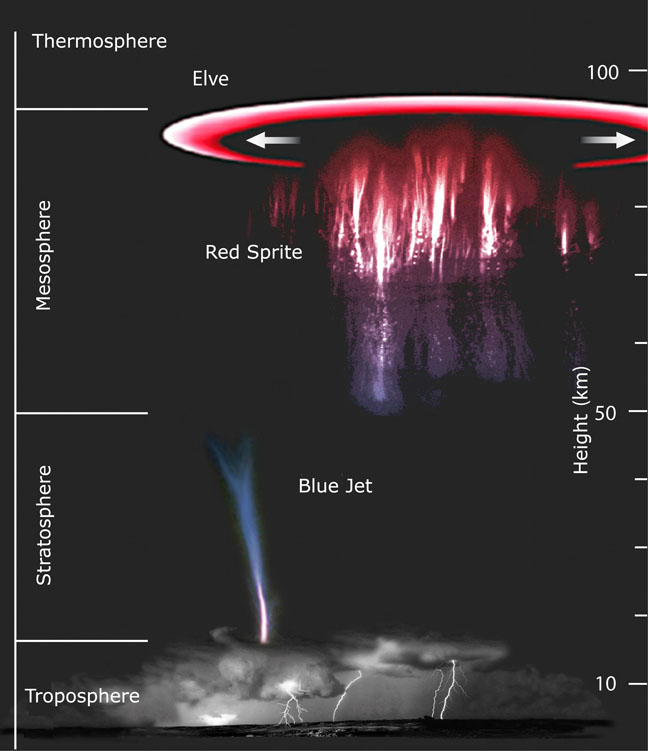 Regarding the last question, I have my own idea: space lighning. Okay, it's perhaps not the best name for it, but if dust particles rub past each other, there's bound to be a build up of an electrical charge. When lightning discharges on earth, it reaches temperatures of up to 28,000 kelvin and frequently turns sand that it hits to glass structures called fulgurites. This certainly seems to meet the temperature requirements. If this happens on a reqular basis over a several billion year period, one might expect some fairly large masses to ultimately fuse together (collisions would regularly break up masses too, and after a certain point gravity and radiation would have the more dominant roles). The problem with my hypothesis however is observability. Electricity arcing through air is highly luminous, but in the vacuum of space it wouldn't give off much light in the arc, but rather as a diffuse cloud as it heated up the dust. Furthermore, lightning is small by comparison to objects that are easily seen with telescopes. Of course, if there's a problem with my reasoning due to my own ignorance, I'd appreciate it if someone corrected me.
Regarding the last question, I have my own idea: space lighning. Okay, it's perhaps not the best name for it, but if dust particles rub past each other, there's bound to be a build up of an electrical charge. When lightning discharges on earth, it reaches temperatures of up to 28,000 kelvin and frequently turns sand that it hits to glass structures called fulgurites. This certainly seems to meet the temperature requirements. If this happens on a reqular basis over a several billion year period, one might expect some fairly large masses to ultimately fuse together (collisions would regularly break up masses too, and after a certain point gravity and radiation would have the more dominant roles). The problem with my hypothesis however is observability. Electricity arcing through air is highly luminous, but in the vacuum of space it wouldn't give off much light in the arc, but rather as a diffuse cloud as it heated up the dust. Furthermore, lightning is small by comparison to objects that are easily seen with telescopes. Of course, if there's a problem with my reasoning due to my own ignorance, I'd appreciate it if someone corrected me.
Scientific pondering to follow:
Three things that I'd like to know are: 1. at what pressure does a magma need to be at to form forsterite? 2. what form of olivine is found in the chondrites? 3. What is the currently favored hypothesis for how loosely agregated masses in the asteroid belt become a single, solid mass that can then differentiate? Anyone who works for Dr. Herd at the U of A should feel free to answer these. If they don't read this blog, more's the pity.
Tuesday, March 14, 2006
Exchange Rates
In the past, with regard to the U.S. economy, I've done very little but complain about the decreasing value of the U.S. dollar compared to the Canadian. For once though, I'm glad that the U.S. dollar is failing. This isn't because I'm unpatriotic or unamerican. Quite the opposite, I'm a capitalist pig who wants to get the most that he can. As a consiquence of leaving much of my funds in a Canadian bank, my money is growing faster than if I had put it into stocks. Furthermore, I have the liquidity that one would expect from any bank account.
Monday, March 13, 2006
Suspicious
I get the feeling that there was an alterior motive to holding a paleontological conference in Maastricht.
Saturday, March 11, 2006
Palaeophis: a snake with thecodont dentition?
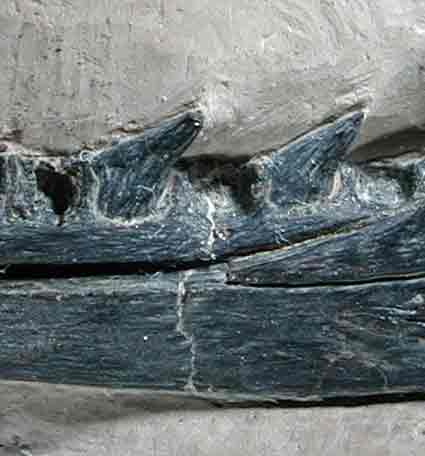 The specimen pictured at the left is of Palaeophis toliapicus from the London clay of the island of Sheppey, in Great Britain. The whole specimen is one that represents the only known complete skull of Paleophis. It is however owned by a private collector who has so far been unwilling to donate it to a public institution. As one can see, the dentitiion is rather unique for snakes, appearing to be thecodont (set in sockets) rather than pleurodont (adhered to the side of the jaw). This is particularly interesting because it bolsters the hypothesis of a mosasauroid (who also have thecodonty) origin of snakes, which is favored by Caldwell, Lee and Scanlon.
The specimen pictured at the left is of Palaeophis toliapicus from the London clay of the island of Sheppey, in Great Britain. The whole specimen is one that represents the only known complete skull of Paleophis. It is however owned by a private collector who has so far been unwilling to donate it to a public institution. As one can see, the dentitiion is rather unique for snakes, appearing to be thecodont (set in sockets) rather than pleurodont (adhered to the side of the jaw). This is particularly interesting because it bolsters the hypothesis of a mosasauroid (who also have thecodonty) origin of snakes, which is favored by Caldwell, Lee and Scanlon.Since this is such a unique specimen and since the owner is simultaneously interested in having it studied and unwilling to part with it, I propose a compromise. If the owner were to donate the specimen to a public museum, it would receive an accession number and then could then be published on. The museum would subsiquently issue the fossil on a long term loan back to the collector so that he may keep it in his personal collection until deciding to have it stored in the museum or his eventual death. Either that, or someone should just find out how much money he wants for the damned thing and raise the funds to buy it from him. Of course, givin the fact that these collectors have found two articulate specimes in the last 10 years, it makes sence that someone aught to send out a field crew and try to find a specimen specifically for a museum.
Friday, March 10, 2006
There's a Lesson Here
"Everything's got a moral, if only you can find it." - Lewis Carroll
If anyone has wondered why I'm blogging so frequently this week when I should be in the field and distantly removed from civilization and computers, it's because I'm stuck here in Flagstaff. The reason is that its snowing here and it would be stupid to try to take an Astro van off road through the snow. Furthermore, it would show equally poor judgement to go out too soon after the snow melts because the hills that I'm interested in are made up largely of bentonite. When wet, bentonite becomes as slippery as grease. It's one thing to get one's car stuck in sand (done that), another thing to get it stuck in snow (done that too), but it's something entirely worse to get it stuck in bentonite.
My situation however smacks of irony. When I came into Flagstaff to re-supply I was sun-burnt from the waist up. In spite of the mild pain, I'd been enjoying the warmth and sunshine so thuroughly that I considered it a large, red badge of honor and was glad to have it. To this end, I mocked those of you in Alberta who were forced to trudge through close to a foot of snow. Now, after over a hundred days without percipitation in Flagstaff, I have to contend with snow, people that have no idea how to drive in snow and the fact that my only entertainment comes from my favorites on the net and going through the NAU library's entire natural history section.
If anyone has wondered why I'm blogging so frequently this week when I should be in the field and distantly removed from civilization and computers, it's because I'm stuck here in Flagstaff. The reason is that its snowing here and it would be stupid to try to take an Astro van off road through the snow. Furthermore, it would show equally poor judgement to go out too soon after the snow melts because the hills that I'm interested in are made up largely of bentonite. When wet, bentonite becomes as slippery as grease. It's one thing to get one's car stuck in sand (done that), another thing to get it stuck in snow (done that too), but it's something entirely worse to get it stuck in bentonite.
My situation however smacks of irony. When I came into Flagstaff to re-supply I was sun-burnt from the waist up. In spite of the mild pain, I'd been enjoying the warmth and sunshine so thuroughly that I considered it a large, red badge of honor and was glad to have it. To this end, I mocked those of you in Alberta who were forced to trudge through close to a foot of snow. Now, after over a hundred days without percipitation in Flagstaff, I have to contend with snow, people that have no idea how to drive in snow and the fact that my only entertainment comes from my favorites on the net and going through the NAU library's entire natural history section.
Thursday, March 09, 2006
Paleo Poetry
What follows after the break is the remainder of the paleontologically inspired poetry that I came up with last night. I had been meaning to take notes on Aristotle's Historia Animalia but found my diversion much more rewarding.
Three attempts at verse:
Ode to an Elasmosaur
Among the many creatures
Who've lived in the briney deep
the plesiosaur is very special
for his neck is quite unique.
It's as long as it is slender
and supports a tiny head;
The head supports his many teeth
that fill fishes full of dread
The length of the neck is what's peculior,
as its not shared by seals, turtles or the whales.
What is this adaptation for?
It's so they can look at their own tails.
Plea From an Inverted Turtle
I am not dead.
I simply cannot right myself
as I am flipped upon my back.
I was put in this position by my rival
in a sudden sneak attack.
He did it because he got it in his head
that to be this way would be deleterious to my health
and thus my chances of survival.
The problem as I see it
arises from my shell
which keeps my feet a pointing skywards
and thus me from moving all that well.
And if you help me get right side up today
it's a courtesy I'd someday be willing to repay.
Reflections from a Mosasaur
"I am not a dinosaur,"
states a lizard gliding through the surf
"I have been much happier
For abandoning the turf.
A land lubber I am not
I much prefer the waves
going about upon the shore
is no way for a Clidastes to behave.
My yellow scales stay bright and clean
And my body long and lean
And if you wonder why I abhor the shore,
The reason's plainly seen.
I enjoy eating till I'm busting
Things a dinosaur finds disgusting
Since I could wish
For no greater dish
Than of calamary or some fish."
Three attempts at verse:
Ode to an Elasmosaur
Among the many creatures

Who've lived in the briney deep
the plesiosaur is very special
for his neck is quite unique.
It's as long as it is slender
and supports a tiny head;
The head supports his many teeth
that fill fishes full of dread
The length of the neck is what's peculior,
as its not shared by seals, turtles or the whales.
What is this adaptation for?
It's so they can look at their own tails.
Plea From an Inverted Turtle
I am not dead.
I simply cannot right myself
as I am flipped upon my back.
I was put in this position by my rival
in a sudden sneak attack.

He did it because he got it in his head
that to be this way would be deleterious to my health
and thus my chances of survival.
The problem as I see it
arises from my shell
which keeps my feet a pointing skywards
and thus me from moving all that well.
And if you help me get right side up today
it's a courtesy I'd someday be willing to repay.
Reflections from a Mosasaur
"I am not a dinosaur,"
states a lizard gliding through the surf

"I have been much happier
For abandoning the turf.
A land lubber I am not
I much prefer the waves
going about upon the shore
is no way for a Clidastes to behave.
My yellow scales stay bright and clean
And my body long and lean
And if you wonder why I abhor the shore,
The reason's plainly seen.
I enjoy eating till I'm busting
Things a dinosaur finds disgusting
Since I could wish
For no greater dish
Than of calamary or some fish."
Wednesday, March 08, 2006
A Permian Parable
A Dimetrodon and an Edaphosaur
One day happened to have a chat
Wherein the Dimetrodon remarked
That they were both getting rather fat.
"The issue with my waistline
Has its roots within my head.
And if you come a little closer
I'll explain just what I mean."
For a moment the Edaphosaur hesitated,
his feeble brain gave him an inckling of dread,
but since they both had sails upon their backs
he figured that they must have temperments equally serene.
"Obesity is caused by caring for our dentition"
continued the Dimetrodon, who smiled as he said
"A little closer perhaps and you'll see
That I keep every single tooth of mine exceptionally clean."
Now, an Edaphosaur is quite stupid
And he is easy to mislead
So that while examining his companion's teeth
he became trapped in between.
Thus by eating other poor pelycosaurs
The Dimetrodon keeps himself well fed.
He gives the appearance of being docile,
but is not what he seems.
One day happened to have a chat
Wherein the Dimetrodon remarked
That they were both getting rather fat.
"The issue with my waistline
Has its roots within my head.
And if you come a little closer
I'll explain just what I mean."
For a moment the Edaphosaur hesitated,
his feeble brain gave him an inckling of dread,
but since they both had sails upon their backs
he figured that they must have temperments equally serene.
"Obesity is caused by caring for our dentition"
continued the Dimetrodon, who smiled as he said
"A little closer perhaps and you'll see
That I keep every single tooth of mine exceptionally clean."
Now, an Edaphosaur is quite stupid
And he is easy to mislead
So that while examining his companion's teeth
he became trapped in between.
Thus by eating other poor pelycosaurs
The Dimetrodon keeps himself well fed.
He gives the appearance of being docile,
but is not what he seems.
Monday, March 06, 2006
Science News
- Snake!
I evidently made a mistake by not applying to do research in Australia. They've aparently found another large, non-macrostomatan (what you typically think of when you think snake) snake. From the picture below a couple of really cool things pop out at me right away. First, the quadrate looks rather similar to the c-shaped condition of mosasaurs. The other thing is that the trigeminal foramen in the prootic of the braincase is open anteriorly and would have been bound on that side by the descending flange of the parietal. I'll grant that this second feature could just be an artifact of breakage, but if not, then it represents the primitive condition also seen in Wonambi. Another cool thing is the jugal. In varanids, the lower half of the orbital margin is made up of a robust jugal. It appears to be the same case here. In a python, there is no jugal. In the defense of people who say that mosasaurs are not the sister taxon to snakes however, this snake has big nasals and small premaxillae (the other way around in varanoids), the frontal-parietal suture is pointed backwards rather than being straight and I see no supratemporal listed in the diagram.
Yurlunggur:

Python
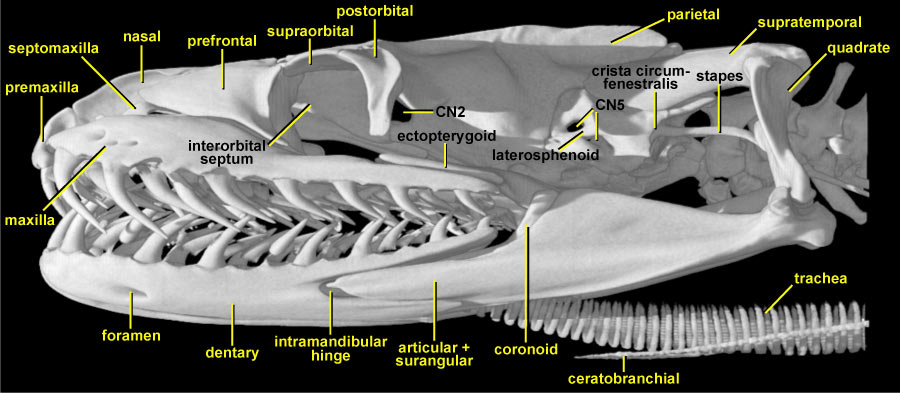
-Immunologists realize that lab mice have two thymuses (thymice?), not one.
I honestly can't blame them too much for missing this little organ for the last two hundred or so years. It's about the size of the head of a pin and looks like a lymph gland. My only concern is that this might be an abaration of using lab mice rather than wild mice. Lab mice are all genetically identical. It's like there are 80 million clones. If however a mutation were to rise in one of the breeding stocks of lab mice (say, for an extra thymus), it wouldn't really get noticed and it might be coinsidence that this particular research team got mice from this mutated stock. In humans, the number of thymuses is incosistant, with most people having one in the chest and some having an additional one in the neck as with these mice. I'd like to see if a wild mouse has an extra thymus.
-Leave it to scientists to find a way to grow tits in the lab.
Naturally, the report only talked about the prospects of this research for treatment of breast cancer and not augmentation.
-Plants produce greenhouse gas
I was forced in high school to memorize the Kreb cycle, the Calvin cycle and several other cycles and pathways that I've since forgotten the name of. But aparently there is a new one that produces methane under normal atmospheric conditions. I can't wait for the conservatives to jump all over this and say that cutting down the rainforest will help eliminate this greenhouse gas.
-Further evidence that my Y-chomosome is mostly junk DNA
Any guy who has taken genetics or who has a girlfriend that has, has been told that only a very small part of the gender determining Y-chomosome actually does anything; specifically regulate the production of androgens and of hair on the earlobes. The rest of the chromosome is there so that it can line up with the X during myocis. To do this, there has to be some similarity to the X, otherwise the two wouldn't come together. Aparently though, this hasn't stopped repeated, massive mutations in the Y-chromosome that further show that you can do a whole lot to it (except have more than one) without deleterious effects.
-Hummingbirds capable of watching scientists
A study conducted on rufus troated hummingbirds provides evidence that the birds are able to remember now only what something looks like and where it is, but when they last saw it. This was done by refilling artificial flowers with nectar at specific intervals. The hummingbirds made a pattern of visiting the flowers right after they were filled. So either they can remember things well, or can deduce that everytime a person goes to a fake flower, it gets refilled.
I (and a few other Albertan Paleontologists) owe Nick Longrich an apology.
Nick didn't make the cover of Scince magazine, nor did he contribute to the article that it relates to. He did however give a talk on the exact same kind of convergence on the semi-aquatic lifestyle in a mesozoic non-eutherian mammal last September at a conference at the Royal Tyrrell Museum. Nick is known among his friends (and we really do consider ourselves friends of his) for being able to talk your ear off for extended periods of time and for drawing dramatic conclusions from only a little evidence. In September he tried to convinse us that didelphadon was semi-aquatic and had a beaver-style, flattened tail. I and a few others were skepticle because he only had two, relatively unrelated pieces of evidence. First was his recognition of some flattened mammalian tail vertebrae, the second was a well known set of robust jaws. The two have never been found together. But this new chinese discovery makes it look like Nick might have been right after all.
I evidently made a mistake by not applying to do research in Australia. They've aparently found another large, non-macrostomatan (what you typically think of when you think snake) snake. From the picture below a couple of really cool things pop out at me right away. First, the quadrate looks rather similar to the c-shaped condition of mosasaurs. The other thing is that the trigeminal foramen in the prootic of the braincase is open anteriorly and would have been bound on that side by the descending flange of the parietal. I'll grant that this second feature could just be an artifact of breakage, but if not, then it represents the primitive condition also seen in Wonambi. Another cool thing is the jugal. In varanids, the lower half of the orbital margin is made up of a robust jugal. It appears to be the same case here. In a python, there is no jugal. In the defense of people who say that mosasaurs are not the sister taxon to snakes however, this snake has big nasals and small premaxillae (the other way around in varanoids), the frontal-parietal suture is pointed backwards rather than being straight and I see no supratemporal listed in the diagram.
Yurlunggur:

Python

-Immunologists realize that lab mice have two thymuses (thymice?), not one.
I honestly can't blame them too much for missing this little organ for the last two hundred or so years. It's about the size of the head of a pin and looks like a lymph gland. My only concern is that this might be an abaration of using lab mice rather than wild mice. Lab mice are all genetically identical. It's like there are 80 million clones. If however a mutation were to rise in one of the breeding stocks of lab mice (say, for an extra thymus), it wouldn't really get noticed and it might be coinsidence that this particular research team got mice from this mutated stock. In humans, the number of thymuses is incosistant, with most people having one in the chest and some having an additional one in the neck as with these mice. I'd like to see if a wild mouse has an extra thymus.
-Leave it to scientists to find a way to grow tits in the lab.
Naturally, the report only talked about the prospects of this research for treatment of breast cancer and not augmentation.
-Plants produce greenhouse gas
I was forced in high school to memorize the Kreb cycle, the Calvin cycle and several other cycles and pathways that I've since forgotten the name of. But aparently there is a new one that produces methane under normal atmospheric conditions. I can't wait for the conservatives to jump all over this and say that cutting down the rainforest will help eliminate this greenhouse gas.
-Further evidence that my Y-chomosome is mostly junk DNA
Any guy who has taken genetics or who has a girlfriend that has, has been told that only a very small part of the gender determining Y-chomosome actually does anything; specifically regulate the production of androgens and of hair on the earlobes. The rest of the chromosome is there so that it can line up with the X during myocis. To do this, there has to be some similarity to the X, otherwise the two wouldn't come together. Aparently though, this hasn't stopped repeated, massive mutations in the Y-chromosome that further show that you can do a whole lot to it (except have more than one) without deleterious effects.
-Hummingbirds capable of watching scientists
A study conducted on rufus troated hummingbirds provides evidence that the birds are able to remember now only what something looks like and where it is, but when they last saw it. This was done by refilling artificial flowers with nectar at specific intervals. The hummingbirds made a pattern of visiting the flowers right after they were filled. So either they can remember things well, or can deduce that everytime a person goes to a fake flower, it gets refilled.
I (and a few other Albertan Paleontologists) owe Nick Longrich an apology.
Nick didn't make the cover of Scince magazine, nor did he contribute to the article that it relates to. He did however give a talk on the exact same kind of convergence on the semi-aquatic lifestyle in a mesozoic non-eutherian mammal last September at a conference at the Royal Tyrrell Museum. Nick is known among his friends (and we really do consider ourselves friends of his) for being able to talk your ear off for extended periods of time and for drawing dramatic conclusions from only a little evidence. In September he tried to convinse us that didelphadon was semi-aquatic and had a beaver-style, flattened tail. I and a few others were skepticle because he only had two, relatively unrelated pieces of evidence. First was his recognition of some flattened mammalian tail vertebrae, the second was a well known set of robust jaws. The two have never been found together. But this new chinese discovery makes it look like Nick might have been right after all.
Saturday, March 04, 2006
Photographic update
It's amazing how quickly one can go through more than 256 megs of memory when taking pictures.
Here are a few for the people who don't check the "my photos" link in the sidebar.
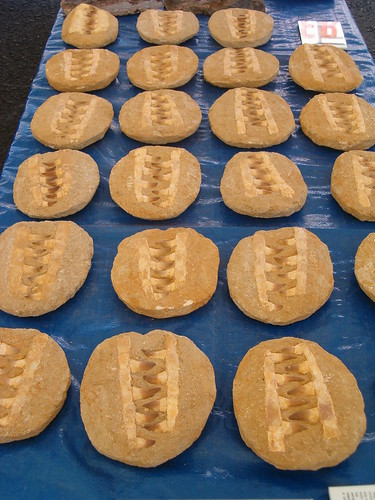
These Moroccan mosasaur jaws which for sale by the hundreds in Tucson are all fakes. The teeth are genuine Prognathodon teeth, but they aren't really set in jaws. They are composites composed of teeth and ribs set in a matrix of sand and adhesive.
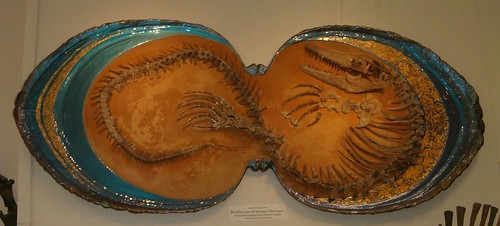
Some people at the Tucson show got a little creative with their fossils; mixing paleontology and art.
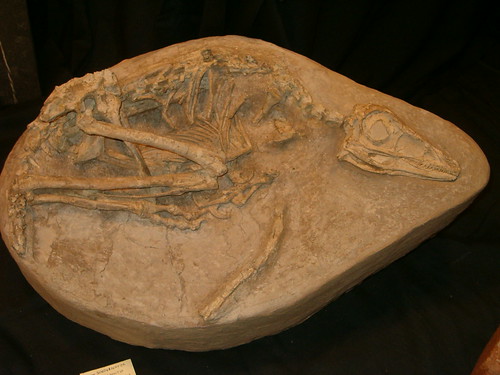
There was some very cool stuff for sale there. This is a mongolian theropod. I don't know what kind, but its probably a troodontid. With the exception of missing a little bit of it's tail, it's a perfect specimen.
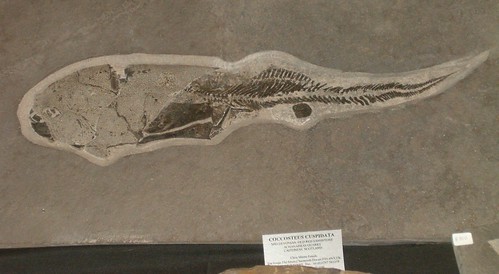
of course, there were fish too.
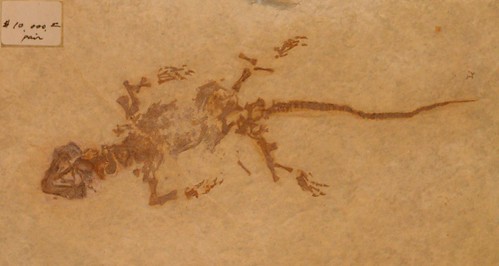
for those of you who are fans of the lizards, this one is from the green river and cost only one quarter as much as the above dinosaur.

an unintentional goatse near the one of the host hotels in Tucson
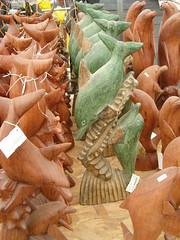
this one is from the Quartzite show. They're supposed to be dolfins, but givin that they are green and have a virtical rather than horizonal tail fluke, they must be ichthyosaurs.
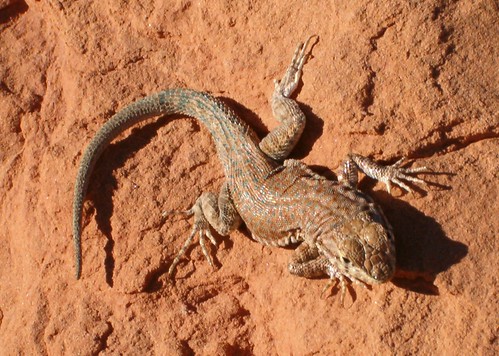
more recently, I've been able to take some excellent macro photos of the abundant lizards in the painted desert east of Cameron, AZ.
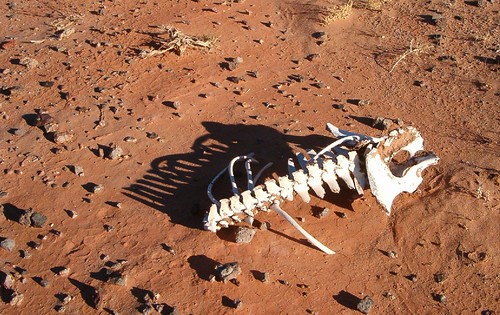
unfortunately, the climate in the painted desert is extremely dry. Consiquentially, there is no wood for me to make a fire with, which has lead me to purchase a propane camp stove now that I'm in civilization again.
For the future, there will typically be a one month lag between when I take a picture and when it ends up on-line since I max out my free flickr account very quickly and am anxious to get as many photos online so as to clear up memory on my USB key.
Here are a few for the people who don't check the "my photos" link in the sidebar.

These Moroccan mosasaur jaws which for sale by the hundreds in Tucson are all fakes. The teeth are genuine Prognathodon teeth, but they aren't really set in jaws. They are composites composed of teeth and ribs set in a matrix of sand and adhesive.

Some people at the Tucson show got a little creative with their fossils; mixing paleontology and art.

There was some very cool stuff for sale there. This is a mongolian theropod. I don't know what kind, but its probably a troodontid. With the exception of missing a little bit of it's tail, it's a perfect specimen.

of course, there were fish too.

for those of you who are fans of the lizards, this one is from the green river and cost only one quarter as much as the above dinosaur.

an unintentional goatse near the one of the host hotels in Tucson

this one is from the Quartzite show. They're supposed to be dolfins, but givin that they are green and have a virtical rather than horizonal tail fluke, they must be ichthyosaurs.

more recently, I've been able to take some excellent macro photos of the abundant lizards in the painted desert east of Cameron, AZ.

unfortunately, the climate in the painted desert is extremely dry. Consiquentially, there is no wood for me to make a fire with, which has lead me to purchase a propane camp stove now that I'm in civilization again.
For the future, there will typically be a one month lag between when I take a picture and when it ends up on-line since I max out my free flickr account very quickly and am anxious to get as many photos online so as to clear up memory on my USB key.
Friday, March 03, 2006
Survey
1. If you had to choose between being blind, deaf or never being able to walk again, which would you choose?
I'd choose to be deaf. I've never seen a scientific journal in brail, it's difficult to study microscopic anatomical features by touch and I've only ever heard of one guy doing field work who couldn't walk.
2. If you could have any suite of super powers (those existing in combination in an established character: eg. Wolverine has claws and healing, Superman has strength, speed, x-ray vision, etc.) which would you choose?
Jedi powers: telepathy + telekinesis + light saber. I'd so abuse them.
3. One physical feature that you don't like about yourself and can't easily change.
I have stubby fingers. It is perhaps why I'm not a professional jazz saxophonist.
4. One physical feature that you like about yourself and isn't likely to change.
my blue-grey eyes
5. Three physical features that you look for in the opposite sex (amend this question for your own preferences)
a. elegant neck
b. slim (preferably weighs the same as or less than me)
c. brunette or red head
6. Three personality traits saught in the opposite sex.
a. intellectual/ nerdy : must be well read
b. cynical/ sarcastic : not necessarily the same but usually go together
c. extrovert in some way. When two hermits get together, they soon seperate.
7. If you could not have your ideal profession (paleontologist in my case) then what is your plan B?
Get my graduate gemologist degree (one semester) and appraise gemstones, especially diamonds, for a living.
8. Which do you relate to more, Calvin or Hobbes?
Hobbes, because he views humanity as inately flawed and is much more sensible and reasonable than Calvin. Furthermore, others go to him for academic help (though his answers are as much smart sounding BS as truth). Also, he is fulling willing if not eager to go exploring. I do however get along with Calvin types, which I suppose is reasonable to expect.
9. How many states, provinces and countries have you been to?
States: 18; AK, AZ, CA, CO, NV, FL, HI, ID, MD, MN, MT, ND, NY, SD, UT, VA, WA, WY
Provinces: 3; BC, AB, MB
Countries: 3; USA, Mexico, Canada
10. Three things that you'd like to do before dieing.
a. write a best seller
b. be the owner and opperator of my own museum
c. anything that makes it so that school children will be forced to learn about me; famous or infamous.
11. Favorite personal possessions.
a. my entire fossil collection - I don't divide that kind of thing up
b. my fedora
I'd choose to be deaf. I've never seen a scientific journal in brail, it's difficult to study microscopic anatomical features by touch and I've only ever heard of one guy doing field work who couldn't walk.
2. If you could have any suite of super powers (those existing in combination in an established character: eg. Wolverine has claws and healing, Superman has strength, speed, x-ray vision, etc.) which would you choose?
Jedi powers: telepathy + telekinesis + light saber. I'd so abuse them.
3. One physical feature that you don't like about yourself and can't easily change.
I have stubby fingers. It is perhaps why I'm not a professional jazz saxophonist.
4. One physical feature that you like about yourself and isn't likely to change.
my blue-grey eyes
5. Three physical features that you look for in the opposite sex (amend this question for your own preferences)
a. elegant neck
b. slim (preferably weighs the same as or less than me)
c. brunette or red head
6. Three personality traits saught in the opposite sex.
a. intellectual/ nerdy : must be well read
b. cynical/ sarcastic : not necessarily the same but usually go together
c. extrovert in some way. When two hermits get together, they soon seperate.
7. If you could not have your ideal profession (paleontologist in my case) then what is your plan B?
Get my graduate gemologist degree (one semester) and appraise gemstones, especially diamonds, for a living.
8. Which do you relate to more, Calvin or Hobbes?
Hobbes, because he views humanity as inately flawed and is much more sensible and reasonable than Calvin. Furthermore, others go to him for academic help (though his answers are as much smart sounding BS as truth). Also, he is fulling willing if not eager to go exploring. I do however get along with Calvin types, which I suppose is reasonable to expect.
9. How many states, provinces and countries have you been to?
States: 18; AK, AZ, CA, CO, NV, FL, HI, ID, MD, MN, MT, ND, NY, SD, UT, VA, WA, WY
Provinces: 3; BC, AB, MB
Countries: 3; USA, Mexico, Canada
10. Three things that you'd like to do before dieing.
a. write a best seller
b. be the owner and opperator of my own museum
c. anything that makes it so that school children will be forced to learn about me; famous or infamous.
11. Favorite personal possessions.
a. my entire fossil collection - I don't divide that kind of thing up
b. my fedora
Subscribe to:
Comments (Atom)